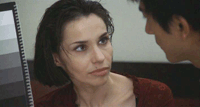Inasmuch as Alain Resnais’s Hiroshima mon amour examines the impossibility of translation in articulating the weight of tragedy, Nobuhiro Suwa’s H story also aligns with Arnaud Desplechin’s Playing ‘In the Company of Men’ in illustrating the inherent limitations of adapting source material to convey the essential story. The ambiguity of language is foretold in the film’s silent, establishing shot of Suwa and lead actress Béatrice Dalle discussing the staging of a hotel room scene – an image capturing the (apparent) mutual understanding between actress and director that is subverted with the introduction of sound, revealing the voice of an off-screen translator mediating their conversation and the presence of a second actor, Hiroaki Umano, waiting for direction nearby. Structured as a day in the life chronicle of the filmmaking process as Suwa and cinematographer Caroline Champetier attempt to shoot a faithful adaptation of Marguerite Duras’s screenplay in a way that consciously rejects the facile restaging of sequences from Resnais’s iconic postwar film, H story is also a layered reflection of a younger generation’s sense of incomplete and disconnected history. This estrangement is captured during a conversation between Hiroshima native Suwa and writer Machida Kuo who is visiting the city to research the life of a hibakusha artist for possible inclusion as a character in his latest novel. For both Suwa and Machida, the bombing represents a distant, intangible history, dislocated from a geographic and moral sense of place.
Interweaving episodes of the difficult film shoot with Dalle’s increasing sense of disconnection in the unfamiliar city, the language barrier is shown not only as a symptom of transplantation and distance, but also as a byproduct of its construction, a problem of textuality that is reflected in her continued struggle with the unnatural patois of Duras’s precisely crafted, poetic screenplay. In a sense, Dalle’s gravitation towards singular images of the bombing rather than large-scale panoramas during a recounted trip to a war museum alludes to her difficulties with the script, where the attention to the form of the language supersedes the content – a rift between reality and its representation. This rupture is also mirrored in Dalle’s restlessness during a trip to a Hiroshima bombing memorial-themed art museum with Machida, where personal expressions of tragedy have been sublimated (or more appropriately, buried) within the public exhibition of commissioned works. Moreover, with the idea of transforming untranslatable tragedy into free-form sculptures and pop art, Suwa revisits an earlier theme in an episode between Dalle and Umano at a riverbank where the two pass the time during make-up by sharing an anecdote about the nearby river as the site where the bombing victims, suffering from thirst and the heat, had once sought relief by drinking the water that had been poisoned by nuclear fallout. Framed within the context of the tragedy-inspired art objects at the museum, the incongruity of their casual conversation serves as an incisive interrogation of society’s tendency towards the aesthetization of horror, where suffering is lost in the abstraction of the spectacle.
© Acquarello 2008. All rights reserved.
